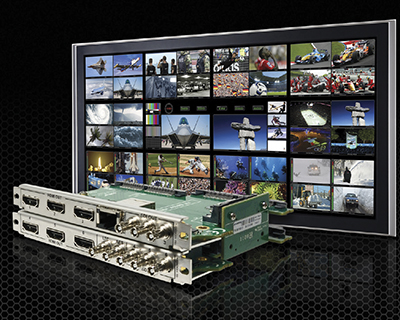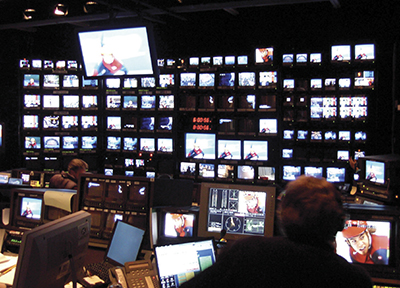Multiviewers Assimilate Newsroom Displays

Harris Broadcast Hview SX Pro multiviewer
ALEXANDRIA, VA.—Multiviewers, coupled with large flat-panel displays, are the proverbial better mousetrap. Television control rooms used to be filled with bulky, hot and frequently temperamental CRT displays, one for each source or signal fed into the room, as well as two or more large CRT monitors for program, preview and other important signals (such as from a DVE system).
As recently as 10 years ago, that was how a control room was built. However, the quick public acceptance of large flatpanel HD displays meant that big reliable monitors were available at prices that would shock an engineer from 20 years ago. This opened the door to devices that allow multiple images to be viewed on a single large display, making multiviewers one of the hottest broadcast products of the past 10 years.
Suddenly, rooms that previously had a couple dozen CRT displays now have two or three sleek flat-panel monitors. Not only does the new way use less power and consume much less space, it just plain looks better. And that’s only the start of the advantages.
So, what do you need to look for in a multiviewer for a news production control room?
“A multiviewer that can accept multiple input formats is key for a news production wall,” said Thomas Tang, president of Portland, Ore.-based Apantac.
You should expect that a multiviewer will accept any traditional video signal from SD to HD-SDI. However, Tang makes the case that it’s a good idea to look for a multiviewer that also accepts a wide variety of computer signal formats, including VGA, DVI and HDMI.
The professional video industry's #1 source for news, trends and product and tech information. Sign up below.
“Instead of converting computer sources into SDI, native support of these computer sources can ensure the image quality is not compromised, as scaling of computer signals is very different than scaling of video,” he said. “Computer inputs allow the newsroom to put up its newsroom computer systems [such as iNews or ENPS], and it’s run down on the same display surface as the rest of the video sources.”
COMPUTER AND VIDEO SOURCES
Apantac offers its Tahoma line of multiviewers, including the DL “Hybrid” system and the Tahoma LI. The Tahoma DL Hybrid can accept up to 16 inputs that can be split in a number of different ways between computer and video sources. For example, the DL-8+8 model can be connected to eight standard video sources (3G/SD/HD-SDI) and eight computer and analog component sources (VGA, YPrPb, DVI, HDMI), with up to four channels of audio per input.

NBC’s control room at the 2002 Olympics in Salt Lake City shows a wall of monitors. That was state-of-the-art at the time, but it’s all been swept away by multiviewers and large flat panel displays. The Apantac Tahoma LI has looping inputs, which makes it a good choice to expand a production switcher that has a built-in multiviewer.
Anything that processes video and audio has the capacity to delay it, a characteristic known as latency.
“Low latency is extremely important due to the live nature of news operations,” said Todd Riggs, product line manager for Englewood, Colo.-based Harris Broadcast.
Control room staff will struggle with latency if there is more than a 30 ms delay between the video shown on the multiviewer display and the live audio, so examining the latency spec and possibly auditioning the product is a good idea.
For news control rooms, Harris Broadcast recommends its Hview SX Pro multiviewer, which is a card that mounts in a Harris Platinum routing switcher. Since multiple Hview SX Pro cards mount in the router, the system uses no additional rack space and cabling is minimized. Each Hview SX Pro card handles up to eight inputs, and each card can feed multiple displays, so there is lots of display flexibility.
“It takes up very little space in the Platinum chassis, which allows for the users to drive large number of displays,” Riggs said. “In addition, it utilizes web tools for easy, intuitive and fast configuration, and can be controlled via Magellan hardware control panels.”
The flexibility and expansion capabilities inherent in some systems make them good choices for control rooms that are used for both news and other production activities. One example is the Evertz MVP multiviewer system, which can expand from 8 inputs with a single output, to more than 1,000 inputs from a mix of source types, and it can drive more than 50 displays.
The Grass Valley Trinix NXT is another popular router that can be fitted with internal multiviewer capability. With the multiviewer installed inside the routing switcher, cabling and installation is much faster than when using a standalone multiviewer.
News control rooms are often eye-catching, but the reality is that they are all business. Multiviewer experts recommend that you consider all the conditions in your area that might affect a live news production.
“It’s important for a multiviewer to have auto-recovery, to be back on-air rapidly after a hardware failure without the need to use a laptop to reconfigure your spare module,” said Martin Jolicoeur, product manager for multiviewers at Miranda Technologies in Montreal.

Miranda Kaleido-Modular-X
Other important multiviewer features that Jolicoeur recommends are integration with the switcher and router for tally management, as well as the ability to have countdown timers and longitudinal timecode (LTC) displays.
Miranda’s Kaleido MX and Modular X feature processing delays of less than 30 msec, and have hot-swappable modules with 90-second auto recovery. Both systems also have built-in router control and third-party switcher interfaces.
SMALL APPS FOR SMALL BUDGETS
For smaller applications on tight budgets, Matrox has its MicroQuad that can place four video windows on a single display. That might not sound like many, but the combination of a MicroQuad and a single 40-inch LCD display is less expensive than one professional-quality CRT monitor from 10 years ago. Two or three MicroQuads and associated displays will outfit a modest control room with an effective monitor wall.
“The MicroQuad is a low-cost quadsplit multiviewer in a very small form factor that takes in four HD or SD-SDI inputs and shows them on a single HDMI output,” said Daniel Maloney, technical marketing manager for Dorval, Quebec-based Matrox Video. “It also allows a user to optionally display a label and/or two audio VU meters per input.”
Sometimes signals need to be viewed full-screen to see the smallest details, and the MicroQuad facilitates that.
“The scaling is done at very high quality but if the smallest details need to be examined, the user can easily switch any input to full screen,” Maloney said. “MicroQuad features on-device push-button control, and also comes with a PC-based app that can be used if the unit is situated in an inaccessible location.”
An interesting possibility is to have multiviewer capability built into a facility’s production switcher, and several companies today have production switchers with built-in multiviewers. For example, the Ross Carbonite switcher can be delivered in a 2 M/E system that includes dual 16-input configurable multiviewers. The Panasonic AV-HS410, Roland V-800HD, Grass Valley GV Director and For-A HVS-390HS and Broadcast Pix Granite, Mica and Flint are all examples of production switchers that include multiviewer capability.
The ability to reduce system complexity by including a multiviewer in a production switcher has its advantages.
“It really depends on the size of the production,” said Apantac’s Tang. “If it is a small operation, then the built-in multiviewer is perfect.”
Tang pointed out that if it’s important for the producer and director to see images that do not go through the switcher (such as the prompter, news automation system display and views of what competing channels are broadcasting), then an external multiviewer may still be needed.
Miranda’s Jolicoeur said that it’s a good idea to check on the quality of a built-in multiviewer before committing to a switcher. “It may have limited processing capability offering lower image quality, which can make video images appear soft and show annoying artifacts,” he said.
Still, all the experts contacted for this article agreed that there are advantages that need to be considered for built-in multiviewers.
Multiviewers have revolutionized the look and monitoring capabilities of control rooms, and their use has spread to all corners of the professional video industry. Compared to the previous methods of monitoring multiple signals (i.e., one CRT display per signal), using multiviewers is a completely different experience.
Multiviewer systems cost less, weigh less, consume less space and power, make less heat, need fewer tweaks and adjustments, and provide a monitoring experience that is more flexible than the CRTs they replaced. The thought of going back to a single monitor for each input signal is��� well, unthinkable.
Bob Kovacs is the former Technology Editor for TV Tech and editor of Government Video. He is a long-time video engineer and writer, who now works as a video producer for a government agency. In 2020, Kovacs won several awards as the editor and co-producer of the short film "Rendezvous."

